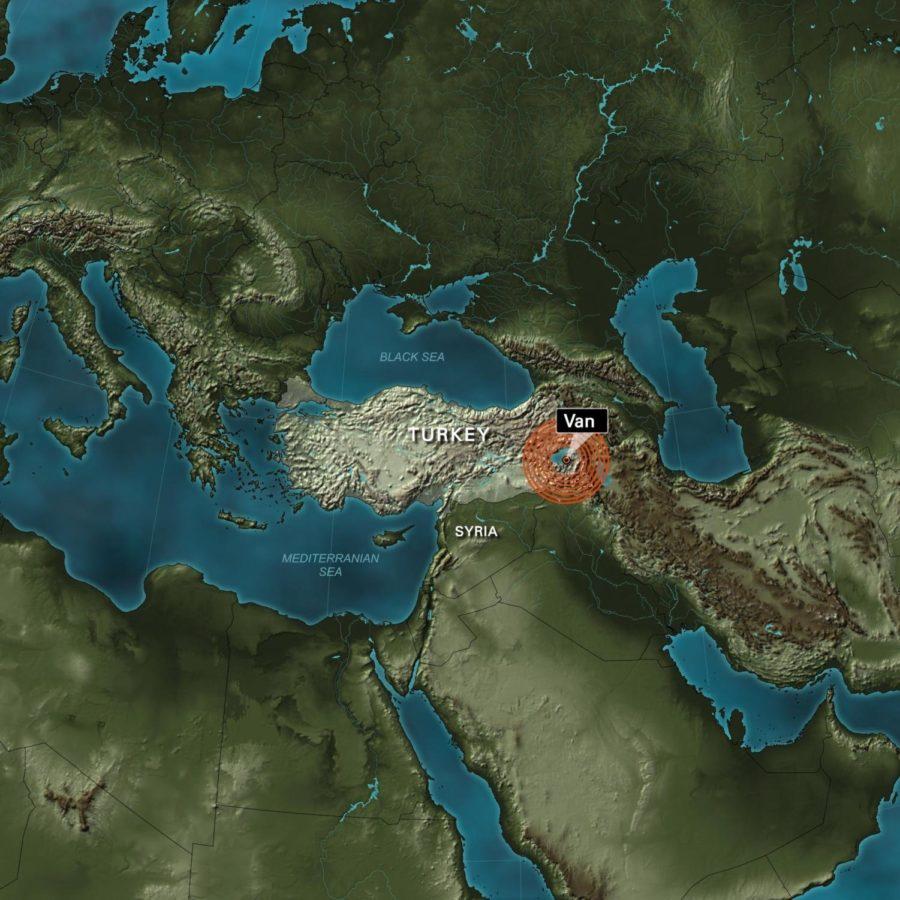Aftershocks rock Turkey, students continue relief efforts
At least four people died and 50 more were buried under rubble from a magnitude-5.7 earthquake that struck eastern Turkey Wednesday night, Nov. 9, officials said.
November 9, 2011
Frequent aftershocks have continued to shake the ground in eastern Turkey’s Van province since the region was struck by a 7.2-magnitude earthquake on Oct. 23.
The most recent of these aftershocks took place Wednesday. Early reports from Today’s Zaman, an English-language newspaper based in Turkey, indicate that the seismic event collapsed the Bayram Hotel, a five-story building that housed journalists and relief workers.
Analysts at Earthquake-Report.com wrote Monday that the quake had claimed 604 lives, injured more than 4,100 and left 241,000 homeless.
As counts of the dead, wounded and displaced continue to rise, Turkish students and faculty are stepping forward to help.
Members of the Turkish Student Association have been collecting aid donations since Oct. 29.
Association members had originally made other plans for that date, which is known to Turks as Republic Day.
“It’s the anniversary of the foundation of the Turkish Republic,” said Abdulkadir Celik, TSA vice president and graduate student in electrical and computer engineering.
Turkish students sometimes celebrate the day with an event. This year, they saw the chance to do more than just honor their country’s past.
“We decided to [do] fundraising for the victims of the earthquake,” Celik said. “It made our Republic Day event more meaningful.”
Celik said the event brought in about $700 from about 100 different donors. He added that all donations would go to the Turkish Red Crescent Society.
The association has continued raising funds since the Republic Day event, collecting more donations at a Sunday morning gathering in University Village for the Islamic feast day Kurbam Bayrami (known as Eid al-Adha in Arabic). The evening of that same day, members sustained fundraising efforts at an International Dessert and Snack Fair, held in the Memorial Lutheran Church. All proceeds from the fair will also go to the Turkish Red Crescent Society.
Halil Ceylan, TSA faculty adviser and associate professor of civil engineering, said the earthquake had shown the consequences of shoddy building practices and lax building code enforcement.
Ceylan cited statistics posted Monday on Earthquake-Report.com that said 2,779 buildings had collapsed, 21,674 were severely damaged and 34,924 were moderately damaged.
Of the many building practices that doomed occupants of badly constructed buildings, Ceylan singled out a few for extended criticism. Among these was builders’ reliance on dangerously thinned-out concrete.
“To make it easily constructable, people add a lot of water to the concrete, so that it flows like a soup,” he said. “Then they don’t have to spend a lot of time to shape the concrete.”
He also bemoaned the critical lack of adhesion between such concrete and the steel beams that are often within it.
“The bond should be between the concrete and the steel. But now you see the reinforcing steel sticking out,” he said, referring to photos of earthquake ruins. “That also shows they did not use the proper steel.”
Ceylan reproached builders for knocking out walls on buildings’ ground floors, a practice responsible for making what civil engineers call “soft stories.” By creating these, he said, builders were removing structural elements that could have helped buildings withstand earthquakes.
“Because they are using these for business purposes, they take out the walls to create open space,” he said. “This significantly reduces the overall stability of the building.”
Ceylan noted that buildings in slum areas of Van were affected worst by the quake. Some of these were made of adobe, a mixture of sand, clay and organic material — a poor choice for a seismically active region like eastern Turkey.
“That’s not the proper material you can use over there,” he said. “That should be eliminated.”
Ceylan added that by not enforcing current building codes, public officials were endangering not only the safety of their fellow Turks, but also their own safety.
“They’re building their own tombs,” Ceylan said.
The fact that the recent disaster could have been averted makes it all the more tragic for the professor.
“In the year 2011, we should not be seeing this level of damage,” he said. “It’s definitely preventable.”
Though Ceylan called the earthquake’s aftermath “heartbreaking,” he said the ongoing student response to it had edified him. He was especially encouraged by the way that students’ concern for all people in their country superseded regional and ethnic allegiances.
“I’m glad we were able to put this campaign together,” he said.

















